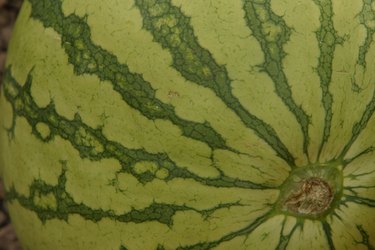
Watermelon is a warm-season fruit that can be grown in all areas of the United States, although the warmer temperatures of the southern regions provide a longer growing period for the plant, often resulting in substantial yields. The fruits can reach an immense size, with many varieties weighing in at 18 to 25 pounds. Watermelon is a common crop in many home gardens and is fairly low-maintenance, but some problems can occur, including conditions that may cause the fruit to turn black and rot.
Diseases
Video of the Day
Several diseases may cause watermelons to turn black. Blossom end rot, for instance, will cause the end of the watermelon to turn black and rot, creating sunken areas on the fruit. This creates conditions for a secondary organism to invade, which may spread the rot throughout the fruit, including black rot or belly rot. Anthracnose, a disease that first affects the foliage of the watermelon vine, eventually advances to the fruit; young fruits turn black, shrivel and die, while older fruits develop circular lesions 1/4 to 2 1/2-inches in diameter that progressively turn dark green to black and ooze.
Video of the Day
Causes
Blossom rot results from a lack of calcium. The soil may be deficient in calcium, or dry soil may limit the availability of calcium to the plant's roots. Soil conditions that fluctuate between dry and wet may also limit calcium availability. Belly rot, or black rot, is spread by fungi, which invade fruit that has been damaged or split, either by the presence of other conditions, such as blossom rot, or by resting on excessively wet soil. Anthracnose is caused by the fungus Colletotrichum orbiculare; damp and rainy conditions may aid its spread in areas where it is present.
Control
To prevent the spread of anthracnose, avoid cultivating watermelon vines when they are wet with rain or dew; apply fungicides as needed. Remove all affected fruit and destroy them. Consult your local county extension for recommendations. Applications of calcium to the plant's foliage may help with blossom rot. Belly rot or black rot can be controlled by staking or caging fruits to keep them from direct contact with wet soil.
Prevention
Plant the watermelons in well-drained soil. Test the soil for sufficient calcium before planting and add lime if needed. Your local county extension may provide soil testing services and recommendations for soil amendment, if required. Use certified disease-free seed and choose disease resistant varieties. Keep the soil evenly moist at all times, particularly when the watermelons first begin to develop. Water to supplement rainfall so the vines receive 1 to 2 inches of water per week, especially during dry spells. Apply a mulch or black plastic film around the plants to help maintain soil moisture and prevent weeds.
- University of Arkansas: Watermelons
- University of Illinois Extension: Anthracnose of Cucumber, Muskmelon, Watermelon, and Other Cucurbits
- University of Florida IFAS Extension: Watermelon Diseases
- University of California Cooperative Extension: Watermelon
- Texas A & M University: Watermelons
- University of Minnesota Extension: Growing Melons (Cantaloupe, Watermelon, Honeydew) in Minnesota Home Gardens